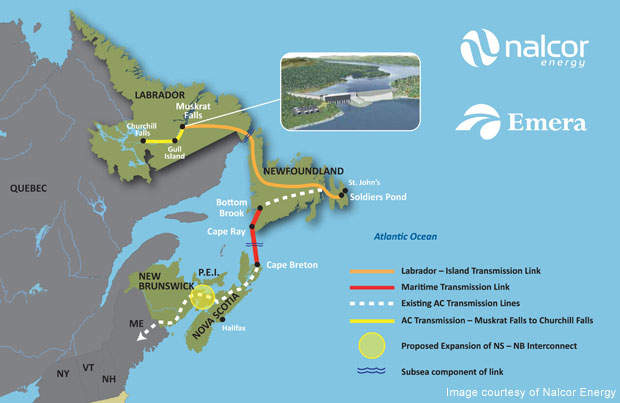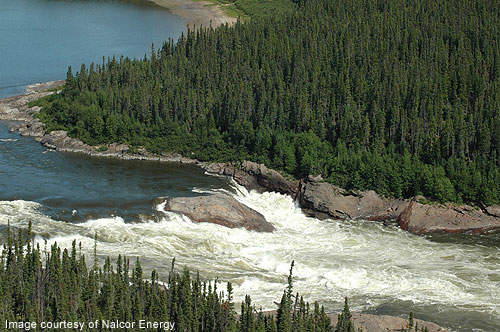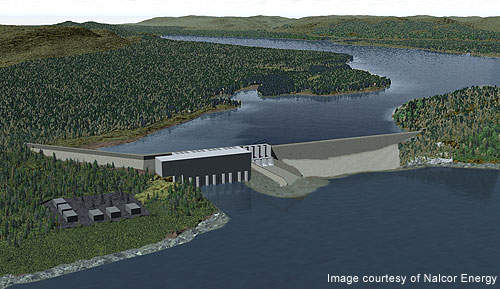The Lower Churchill Project (LCP) is a hydroelectric project being developed on the lower side of the Churchill River in North America. Estimated to cost $6.2bn in total, the project is being developed by Nalcor Energy and Emera, a subsidiary of Nova Scotia Power.
The project comprises two sub-projects known as the Generation Project and the Transmission Project.
As part of the Generation Project, power generating stations will be built at Gull Island and Muskrat Falls in the Central Labrador region. The power stations will together generate 3,074MW. Transmission lines will be laid between Gull Island, Churchill Falls and Muskrat Falls.
The second sub-project involves the laying of 1,100km-long and 450 high-voltage direct current (HVdc) link from Muskrat Falls Hydroelectric Generating Facility to Soldier’s Pond in Newfoundland’s Avalon Peninsula. The transmission project is referred to as the Labrador-Island Link project and expected to be completed by 2016.
The LCP completed environmental assessment in June 2013. Construction began in 2013 with a scheduled target opening in 2017. The project will result in the Labrador and Newfoundland’s electrical system running on 98% clean and renewable energy.
Project details
The LCP is intended to make use of the untapped hydroelectric potential of the Churchill River to meet future electricity needs. About 65% of the potential generating capacity of the river is being utilised by the 5,428MW Churchill Falls Generating Station, which was commissioned in 1971.
The project is also a major part of the strategy of Labrador and Newfoundland to reduce greenhouse gas emissions. It claims to offset 16Mt of carbon dioxide emissions a year.
It is being constructed in two phases. Construction of the Muskrat Falls Generating Station and Labrador-Island Link project forms Phase I. Phase II involves the construction of the Gull Island Generating station and Maritime Transmission Link between Bottom Brook in Newfoundland and Cape Breton in Nova Scotia.
Development
Nalcor Energy and Emera signed the project partnership agreement in November 2010. As per the agreement, the Muskrat Falls Generating Station will be 100% owned and operated by Nalcor Energy and the entire Transmission Line project will be owned by Nalcor Energy and Emera in the proportion of 51% and 49%, respectively.
Nalcor Energy reserves the right to acquire full ownership of the Labrador-Island Link at any time.
About 20% of the Muskrat Falls output will be provided to Emera for an investment of $1.2bn, or 20% of the total project’s cost. Emera will also be responsible for 20% of the overall operating cost of the project over a 35-year contract period.
Emera will invest $600m in the Labrador-Island Link. In return, it will get Nalcor’s transmission rights in Nova Scotia, New Brunswick and New England. Ownership of the Maritime Link will be transferred to Nalcor Energy at the end of the contract period for $1.
In addition to the above clauses, the agreement focuses on the economic development of the region by reserving jobs for the local population in Labrador.
Plant details
The Gull Island power station will have five Francis turbines and generate 2,250MW. It will provide 16.7TW/h of electricity a year.
The Muskrat Falls generating station will have four propeller or Kaplan turbines and generate 824MW.
Construction
The project involves large-scale construction at Gull Island and Muskrat Falls.
The Gull Island reservoir will be 232km-long. A concrete-faced and rock-filled dam measuring 99m high and 1,315m long will be constructed at the site.
The Muskrat Falls reservoir will have a 32m-high and 432m-long dam in the north abutment of the river and another dam in the south abutment, measuring 29m high and 325m long.
The interconnecting transmission lines of the Generation Project include laying of a 203km-long 735kV line between Gull Island and Churchill Falls and a 60km-long double-circuit 230kV line between Muskrat Falls and Gull Island. These lines will be installed to the north of the Churchill River with the support of lattice-type steel structures.
The Transmission project includes the construction of a substation to convert a portion of AC power into DC in Gull Island and to reverse the DC into AC at Soldier’s Pond. It also involves the laying of a 407km-long and 60m-wide overhead HV DC line between Gull Island and Strait of Belle Isle, placing of three to five submarine cables in the strait of Belle Isle and 760km-long overhead HV DC cables from strait of Belle Isle to Avalon Peninsula.
Transmission Link will facilitate transportation of 800MW of power from LCP to the island while creating opportunities for future power exports. It is an important component of the province’s energy plan released by the government of Labrador and Newfoundland in September 2007.
Construction of one of the three cables was completed in January 2015 and concrete placement in the spillway was completed by Astaldi Canada in October 2015.
Construction on the Labrador-Island Link project between Muskrat Falls and Churchill Falls began in May 2014. Parallel high-voltage alternating current (HV AC) transmission lines are being constructed in Labrador to connect Muskrat Falls and Churchill Falls generating stations.
Contractors involved
The engineering, procurement and construction (EPC) contract for Phase I was awarded to Canada-based SNC-Lavalin in March 2011.
Valard Construction was contracted to install transmission infrastructure for the Labrador-Island Link project.
Astaldi Canada was awarded a contract for the major civil works of the Muskrat Falls hydroelectric generating facility.






